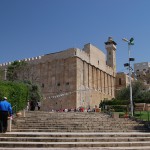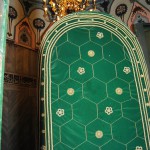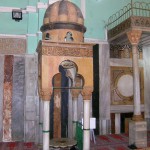Cave of Machpelah (Hebron)
In Israel, in the city of Hebron, in its ancient part, there is located one of the most revered sites for Jews, Christians and Moslems – the cave of Machpelah. The word Machpelah in Hebrew means “the double one,” or the “paired one.” It is difficult to say now how this name originated, but there are theories according to which the name “double” (or “paired”) could be used because of the cave’s structure (it has two layers), or because of the terrace-type location of the cave and the field.
The city Hebron proper, where the tomb of Machpelah is situated, is one of the most ancient cities in the world. The city lies in the southern part of mountainous Judea, in a flourishing intermountain valley. As early as in the Ist century AD, famous Jewish historian Josephus Flavius asserted that Hebron was 2300 years old. Israelites who had adopted sedentary lifestyle, settled in it during the times of Abraham. The city of Hebron was also named among the refuge cities.
Hebron is also the first capital of Israel. It was from Hebron that king David ruled during the first seven years of his reign, before Jerusalem was captured and the capital was moved over there. And even before that, Abraham bought a piece of land from Ephron the Hittite for a family sepulcher, and there was a cave, in which, according to tradition, the tombs of Adam and Eve had already been. We learn about the burials of Adam and Eve in that cave from different ancient sources. St Augustine in his works mentions king Seawulf, who traveled to the Holy Land in the beginning of XIIth century, saying that in the cave of Machpelah, besides patriarchs and matriarchs, the first people Adam and Eve were interred. This is also mentioned in an anonymous treatise of the XIIIth century “Concerning the Land of Jerusalem.” The first book of Moses, Genesis, has a detailed narration about the purchase of the cave of Machpelah by Abraham for the burial of his wife Sarah,
«Sarah lived to be a hundred and twenty-seven years old. She died at Kiriath Arba (that is, Hebron) in the land of Canaan, and Abraham went to mourn for Sarah and to weep over her. Then Abraham rose from beside his dead wife and spoke to the Hittites. He said, “I am a foreigner and stranger among you. Sell me some property for a burial site here so I can bury my dead.”The Hittites replied to Abraham, “Sir, listen to us. You are a mighty prince among us. Bury your dead in the choicest of our tombs. None of us will refuse you his tomb for burying your dead.”Then Abraham rose and bowed down before the people of the land, the Hittites.He said to them, “If you are willing to let me bury my dead, then listen to me and intercede with Ephron son of Zohar on my behalfso he will sell me the cave of Machpelah, which belongs to him and is at the end of his field. Ask him to sell it to me for the full price as a burial site among you.”Ephron the Hittite was sitting among his people and he replied to Abraham in the hearing of all the Hittites who had come to the gate of his city. “No, my lord,” he said. “Listen to me; I give you the field, and I give you the cave that is in it. I give it to you in the presence of my people. Bury your dead.”Again Abraham bowed down before the people of the landand he said to Ephron in their hearing, “Listen to me, if you will. I will pay the price of the field. Accept it from me so I can bury my dead there.”Ephron answered Abraham, “Listen to me, my lord; the land is worth four hundred shekels of silver, but what is that between you and me? Bury your dead.”Abraham agreed to Ephron’s terms and weighed out for him the price he had named in the hearing of the Hittites: four hundred shekels of silver, according to the weight current among the merchants.So Ephron’s field in Machpelah near Mamre—both the field and the cave in it, and all the trees within the borders of the field—was deeded to Abraham as his property in the presence of all the Hittites who had come to the gate of the city.Afterward Abraham buried his wife Sarah in the cave in the field of Machpelah near Mamre (which is at Hebron) in the land of Canaan. So the field and the cave in it were deeded to Abraham by the Hittites as a burial site.» (Genesis, chapter 23).
Since the time when Abraham bought the field and the cave in it, the cave of Machpelah became the family sepulcher for the Biblical patriarchs. Now there is an ancient monumental construction hovering over the cave with walls 12 meters high. The masonry of the wall is made of cut stones over six meters long. In its architectural style, the construction is akin to the constructions in Jerusalem and dates back to the epoch of Herod the Great. Josephus Flavius tells us that the tombs of the patriarchs are made skillfully out of beautiful marble, but he does not mention the outer walls. The tombs of Abraham and Sarah are located in the center of the construction, Jacob’s and Leah’s tombs – in the north-west section (probably, at the initial entrance), and Isaac’s and Rebecca’s – in the south-eastern part. In all probability, originally the construction had no roof.
During the Byzantine period, the south end of the construction with Isaac’s and Rebecca’s tombs was made into a church that later became a mosque. In the mosque’s floor there are two openings that lead to the cave; one is blocked by stone slabs and the other one is open: according to the Muslim tradition, the ever-burning lamp is lowered into it.
The appearance of the underground section of the MachpelahCave is not known, but according to the known written sources one may surmise that the cave has two sections connected by a passage. There may be another cave, the inner one. Nothing is known about other entrances to these caves, except for those that are in the mosque.
In 1267, a Mamluk sultan Beybars I forbade Christians and Jews from entering the cave; at the same time, Jews were allowed to climb five, and later seven steps on the outer side of the eastern wall and put notes with their requests to God into a hole in the wall next to the fourth step. This opening, going through the entire wall 2.25 meters thick and leading into the cave under the floor of the building is first mentioned in 1521 and, most probably, was made at the request of the Jews of Hebron after they had paid a considerable sum of money.
The decree of sultan Beybars I forbidding Jews and Christians from entering the caves was kept until the XXth century. Nevertheless, there were some exceptions; for example in 1862, because of especially favourable relationships between Turkey and Great Britain, the Ottoman authorities of Hebron allowed Prince of Wales Edward, who had a personal permit from sultan Abdul-Azis I, to visit the cave of Machpelah. Thus, he was the first Christian who was able to walk into the cave of Machpelah after six centuries (since 1267).
Only in 1967, after the Six Day War, the access for Jews and Christians was officially granted again after seven hundred years. Today, the territory of the monument is under the oversight of a Muslim community, but part of the complex is used as a synagogue.
The burial sepulcher of the Biblical patriarchs has been surrounded by mysteries from the days of old. Stories and legends that have been formed around the forefathers’ cave in Hebron are soaked with mysticism and mystery.
In particular, according to one of the stories, after the fall of the FirstTemple in Jerusalem the Lord sent prophet Jeremiah to Hebron, to the grave of the forefathers with the news about what had happened; then, having heard about the fall of the Temple, the forefathers tore their clothes and cried bitterly.
In 1643, Machpelah was visited by a sultan of the Ottoman Empire. As he inspected the mosque, the sultan accidentally dropped his scimitar into the opening in the floor, through which it fell into the burial grotto of the patriarchs. At the sultan’s order, several servants were lowered down on ropes to retrieve the scimitar, but all of them were dead when they pulled up from the cave. Local Muslim dwellers even under the threat of death penalty refused to go down into the grotto. Then one of the sultan’s advisors recommended him to demand from the Jews to bring the scimitar back.
Abraham Azulai (author of several books, including the most known Chesed le-Abraham) picked up this mission and descended into the cave. There he met Adam and Eve, Abraham and Sarah, and other forefathers, who announced to him that he had to depart from this world. But in order to save the Jews of Hebron from the persecution that could be provoked by the sultan’s anger, Abraham Azulai was allowed to be the first man in history, who would go back from the cave of the forefathers. The scimitar was returned to the sultan, and one day later Abraham Azulai died.
Territorially, Hebron is part of the so called Jerusalem Speleological district. This region impresses with its variety of cave types. For example, the limestone formations of Ofra are huge cirque fields cut through by vertical sinkholes up to 50 meters deep; limestone caves of Beit Shemesh are well developed horizontal caves; the area of Bethlehem and Hebron are whole karst systems that are quite often watered by an underground collector.
From the ancient times the caves in this area have been used by man as storage facilities, homes for living, barns for cattle, workshops, etc. Today, in the corner of the magnificent Machpelah cave one can see a classical karst sinkhole six meters in diameter and five meters deep. The bottom of the sinkhole is cemented, and tour guides for a few decades now as they answer the question about its nature are saying that it is a “swimming pool.” In actuality, according to the geological map this is a bare fragment of a fault that ends 30 kilometers east of this spot in an active stream falling into the Dead Sea.
When during the Six Day War, on June 8 of 1967, Hebron was captured by the Army of Defense for Israel, and the entrance to the building over the burial site of the patriarchs was granted to non-Muslims again, there were many of those who tried to get into the burial chamber through a narrow opening in the mosque’s floor (into which the sultan’s scimitar once fell). The diameter of the opening was no more than thirty centimeters wide.
Moshe Dayan (former Israel’s Defense Minister) narrates of the first visit to the sepulcher in 700 years in his book Living with the Bible, “The first one to descend through it was Michal, the daughter of one of our officers, thin twelve year old girl, courageous and smart, who was not only afraid of the spirits and demons that have not been proved to exist, but also of snakes and scorpions that pose a real threat… As she descended into the cavern with a lantern and a camera, she took several shots and made some sketches of what she had seen in pencil. It turned out that there were tombstones in the vault, Arab inscriptions of the Xth century AD, niches, steps leading upstairs, although the passage was blocked – moreover, no traces of doors could be seen in those pictures.”
Michal herself described her speleological expedition later, “On Wednesday, October 9, 1968, my mother asked me whether I would agree to go down into the vault of the cave of Machpelah… The car started to move and soon we were in Hebron… I got out of the car, and we walked toward the mosque. I saw the opening, through which I had to go down. It was measured, and its diameter was 28 centimeters. They tied me up with ropes, gave me a flashlight and matches (to determine the presence of oxygen inside) and started to lower me down. I landed on a heap of papers and banknotes. I found myself in a square room. In front of me there were three tombstones, the middle one was the tallest and more decorated than the other two. In the opposite wall from me there was a small square hole. They loosened the rope above, and I managed to crawl through it to find myself in a low, narrow corridor cut in the rock. The corridor had the shape of a rectangular box, There was a stairway at the end of it and its steps ran into the closed up wall… I measured the narrow corridor with my steps – it was 34 steps long. As I was walking down I counted sixteen steps, as I walked up – only fifteen. I walked up and down five times, but the result was always the same. Every step was 25 centimeters high. I walked up the stairs the last time and knocked on the ceiling. Someone knocked back to me. I walked back. I was given a camera and came down again to take pictures of the square room, tombstones, corridor and the stairs. Then I came up again, took a pencil and paper and came down to make some drawings. I measured the room with my steps – six to five. The width of every tombstone was one step and the span between the tombs was also one step. The corridor was one step wide, and its height – close to one meter.
They brought me out. As I was being pulled up, I dropped the flashlight, so I had to go down, and then come up again. Michal.”
Apart from this description of the burial sepulcher in the cave of Machpelah, there is just no other one that would be more detailed. Because of this humble description, we can imagine, at least approximately, the looks of the inner rooms of the burial vault of Biblical patriarchs.
Today, the hole through which Michal descended into the sepulcher is closed by a stone slab, and no one has come down into the vault ever since – the guards of the mosque and Israeli police are closely watching for it. The only opening into the vault that is left open is the shaft which is under an awning on four pillars, into which, according to Muslim tradition, the ever-burning lamp is brought. The glittering of the burning lamp can be seen if one looks down into the hole. The light of the lamp is to remind all the visitors of the Machpelah cave about the light of the paradise garden, which, according to tradition, our forefather Adam saw here.
Materials are taken from the Internet.





